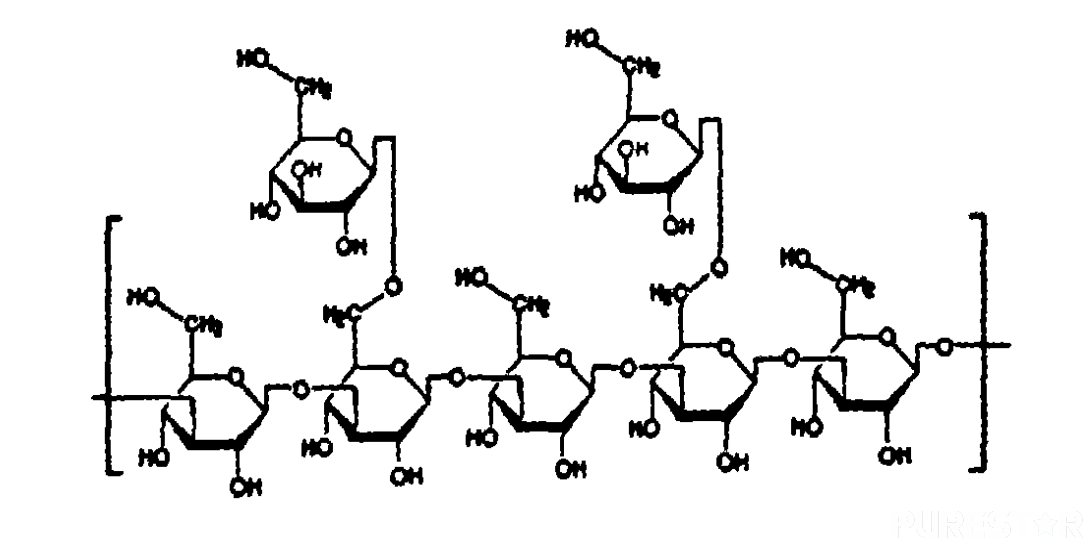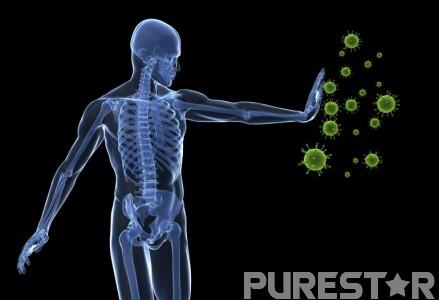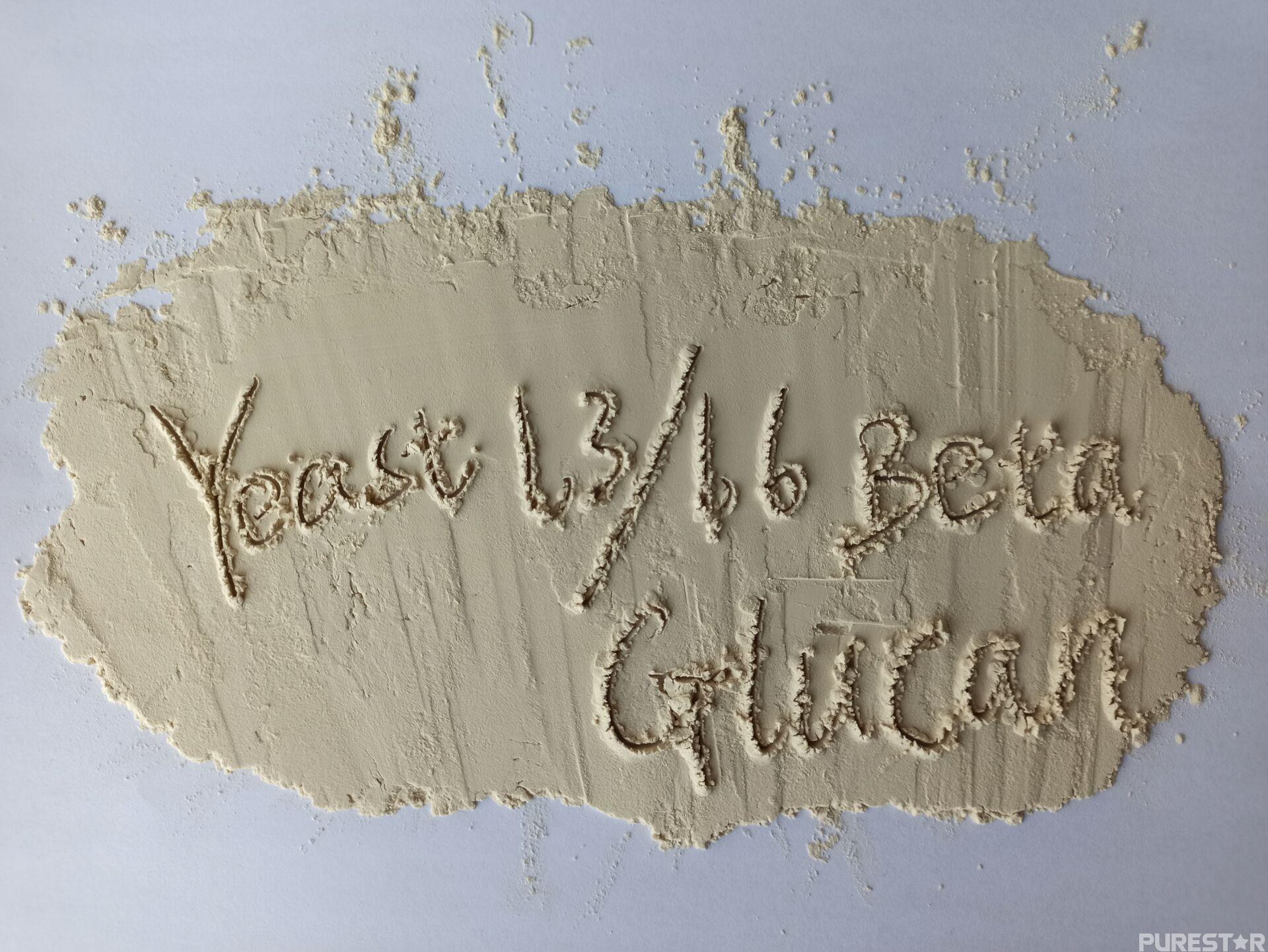β-1,3-D-glucan is a polysaccharide that widely exists in microorganisms, mushrooms and plants, and it is one of the macromolecules that make up the cell wall structure of higher plants, yeast and fungi. Yeast cell wall is one of the important sources of β-1,3-D-glucan with strong biological activity. The yeast cell wall is about 70mm thick and accounts for about 20% of the dry cell weight. Yeast cell walls are mainly composed of three polysaccharides: mannoprotein (about 40%), glucan (about 50%), and chitin (about 2%). Yeast glucan includes alkali-insoluble glucan and alkali-soluble glucan, of which alkali-insoluble β-1,3-D-glucan accounts for 85%). G Guizand et al. used X-ray methods to prove that yeast insoluble glucan exists as a triple helix, and the three polysaccharide chains are arranged in parallel and wound, and are in a stable state through interchain hydrogen bonds.

People's interest in yeast glucan began in the 1940s, when Dr. Pillemer first discovered and reported that there is a substance called "Zymosan" in the yeast cell wall that can non-specifically stimulate the immune system. In the 1960s, Dr. Nicholas DiLuzio of Tulane University confirmed that the biologically active substance in Zymosan was β-1,3-D-glucan, and isolated this substance from baker's yeast.
In recent years, a large number of studies have shown that yeast glucan can stimulate the activity of macrophages by binding to the special receptors of macrophages, thereby enhancing their non-specific immune functions to achieve anti-tumor, anti-inflammation, and promotion of wound healing etc. active functions.
As mentioned above, the main component of yeast cell wall is glucan, and there are also some mannoproteins, proteins, lipids and a small amount of chitin. Yeast glucan is mainly alkali-insoluble glucan. Alkali-insoluble glucan is a kind of active polysaccharide. The key to prepare alkali-insoluble glucan from yeast cell wall is to remove impurities such as protein, mannan and lipids. At present, the preparation methods of yeast glucan domestic and abroad mainly include acid-base method, enzymatic method and oxidation extraction.
Mannaners et al. first used the acid-base method to extract glucan from yeast, and after Williamms et al. improved, this method has formed a stable process. The alkali treatment process studied by Chung et al. is as follows: suspend 80 g of yeast cell walls in 1000 mL of 4% NaOH solution, incubate at 95 °C for 1 h, and centrifuge; suspend insoluble matter in 2000 mL of 3% NaOH solution, and incubate at 75 °C for 3 h. Centrifuge; suspend the insoluble matter in distilled water, adjust the pH to 4.5 with hydrochloric acid, incubate at 75°C for 1 hour, centrifuge, wash with water, dehydrate and dry to obtain yeast glucan. During acid treatment, the choice of acid has a great influence on the yield of glucan. If the acidity is too weak, the removal of acid-soluble glycogen and β-1,6-glucan will not be complete. If the acidity is too strong, the alkali-insoluble glucan will be degraded and the yield will be reduced. Therefore, when the pH is adjusted to 4.5 with acetic acid, the effect optimal.
The acid-base method is fast and efficient. Although it can obtain high-purity glucan products, it requires a large amount of acid and alkali, causes serious environmental pollution, requires the use of organic solvents, and causes certain damage to the glucan molecules. In order to overcome this deficiency, researchers at home and abroad have adopted a milder process to extract yeast beta glucan. Freimund et al. used enzyme method to treat yeast cell wall to prepare yeast beta glucan: take 1.3kg yeast cell wall and add 8.8L of water, adjust pH=7.0, keep Sh at 125°C, wash twice after centrifugation, add water to 10L for insoluble matter, then use alkali protease——Savinase enzyme treatment for 5 hours, centrifuged, washed, dried and washed with ethanol or acetone to obtain a glucan sample with a content of more than 85%. Tang Zhiyu et al. used enzyme-alkali combination method to extract yeast cell wall, treated autolyzed yeast with papain for 18 hours, collected the precipitate, and treated it with 2% NaOH for 3 hours at high temperature, and obtained the polysaccharide content of the sample was over 87%, and the yield was 10%. Zhao Guangyuan et al treated the yeast cell wall with protease at 57°C for 24h, then treated the centrifuged sediment with 2% NaOH at 60°C for 3.5h, centrifuged, washed, and dried to obtain yeast glucan samples. Enzyme treatment of the yeast cell wall can remove a large amount of protein, thereby reducing the concentration and usage of subsequent alkali, making the molecular structure of the yeast glucan product more complete. The molecular structure of glucan is closely related to its biological activity. Therefore, the enzymatic method is more suitable for the extraction and purification of large-scale yeast beta glucan.
In addition to the traditional acid-base method and enzymatic method, some researchers also use other methods to produce yeast beta glucan products with higher purity. Japanese Ohno et al. used sodium hypochlorite to directly treat yeast cell walls, used 0.5% to 2% sodium hypochlorite solution to treat yeast cell walls at room temperature for more than 5 hours, and obtain high-purity yeast glucan products with a yield of more than 20%. Yanjun et al. also used the same way to treat yeast cell walls to obtain yeast glucan products with higher purity. Although this method can obtain high-purity yeast beta glucan, the effect of strong oxidants on the molecular structure of glucan needs to be further studied to investigate the impact on its physiological activity.

Because oral yeast beta glucans are different from other food ingredients, they are not hydrolyzed by the acids or enzymes in the stomach and intestinal tract and pass directly through the small intestine. Macrophages on mucous cells of the small intestine take up glucan through glucan receptors, which then activate these cells. Beta-1,3-D-glucan works by stimulating macrophages, a type of white blood cell that play a broad role in protecting and strengthening the immune system, protecting the body from harmful substances. Macrophages are the main type of cells involved in non-specific immunity, which can engulf foreign particles and destroy them; macrophages also provide signals to other immune cells such as B cells and T cells to move towards the infected site; It also produces growth factors to repair damaged tissue.
The anti-tumor effect of glucan is the result of stimulating the immune system, rather than directly acting on the toxic cells of the tumor. The advantage of this effect over traditional treatments is that immune cells have the ability to recognize and destroy "bad" cells and "foreign invaders", so glucan does little harm to healthy tissues and cells. The main goal of current research on anticancer function is to enhance the activity and phagocytic ability of macrophages in higher mammalian tissues. One of the functions of yeast glucan is to enhance the ability of macrophages. In 1981, the Norwegian Cancer Research Center and Uppsala University in Sweden compared the immunity of 42 natural polysaccharides, and found that glucan extracted from yeast and fungi could increase the phagocytosis of macrophages in mice by more than 10 times. Subsequent studies pointed out that it has the same effect on the immune effect of other mammals including humans. Numerous animal studies have found that β-glucan is effective against various types of tumors. Examples include ovarian cancer, male germ cell tumors, lymphosarcoma, tumor lung metastases, renal cell carcinoma, etc.
In 1982, a study by Tulum University School of Medicine in the United States showed that after a high concentration of E. coli was injected into mice fed with β-glucan, within a few hours, both the death rate and the bacterial concentration in the blood were much lower than those of the unfed mice. In 1990, researchers published in the Scandinavian Journal of Immunology, a rat peritonitis model infected with E. coli. in the non-intervention group with β-1,3-D-glucan, the leukocytes in the infected rats gradually increased, and died within 12 hours. However, the number of E. coli in the peritoneal fluid of rats in the intervention group was still 0 after 24 hours.
In the 1980s, Harvard University’s research successively showed that β-1,3-D-glucan can help people resist the invasion of various pathogenic bacteria, such as Staphylococcus aureus, Escherichia coli, Candida albicans, Listeria monocytogenes, Cardiac Pneumocystis, Leishmania, herpes virus and roundworm etc. Researchers have also carried out glucan anti-infection research on different animals, such as mice, rats, guinea pigs, pigs, etc., showing its ability to enhance the body's immunity and improve infection conditions.
Scientific research has proved that yeast β-glucan can significantly increase the effectiveness of antibiotics; when used in combination with antibiotics, its ability to stimulate macrophages can increase the therapeutic effect of drugs. While β-1,3-D-glucan enhances the body's own ability to resist bacteria, antibiotics can inhibit bacterial invasion and improve the body's disease resistance. Experiments on peritonitis in rats confirmed that the survival rate of rats treated with β-1,3-D-glucan alone was 80% (the survival rate of the control group was 20%), and the survival rate of rats treated with antibiotics alone was 65%, while the two at the same time have a 100% survival rate.
Research by the U.S. Institute of Radiation Biology has shown that yeast beta glucan can well help the immune system recover and rapidly improve resistance after radiation. After giving a lethal dose of radiation, all the mice in the control group died after 2 weeks, while the mortality rate of the mice taking yeast glucan was only 40%. Treating irradiated mice with β-1,3-D-glucan can enhance the ability of mice to recover, and can improve their bone marrow vitality, increase the number of white blood cells, and enhance the number of spleen cells. Some studies have found that the repeated skin ulcers on the chest wall of some female breast cancer patients after surgery and radiotherapy can be completely cured after being treated with β-1,3-D-glucan, which is related to the fact that glucan prevents post-radiation infection and promotes skin regeneration.
β-1,3-D-glucan has the functions of absorbing bile acids and promoting the excretion of bile acids, promoting the transformation of cholesterol into bile acids, and maintaining the inherent normal metabolism of cholesterol. β-1,3-D-glucan causes viscosity-induced malabsorption, and β-1,3-D-glucan increases the excretion of bile salts, which may be the two main reasons for β-1,3-D-glucan can lower cholesterol. Nicolosi et al. conducted a study on 15 obese men with high cholesterol. In the study, the patients kept their body weight unchanged, and the total cholesterol content in the blood decreased by 8% in the 7th week, on this basis, it decreased by 6% in the 8th week. It can be seen that yeast β-1,3-D-glucan can significantly reduce the cholesterol content in plasma.
Based on yeast beta glucan has efficient functions of enhancing immunity, inhibiting harmful bacteria and dietary fiber, and it is widely used in animal feed, food, cosmetics and other fields.

Yeast beta glucan is a good natural immune enhancer, which can provide the body with nonspecific and specific immune effects. This is an important way to improve animal health and is widely used in the field of animal breeding. Selvaraj et al. showed that intraperitoneal injection of glucan to carp can significantly improve the immune function of carp. Courie et al. added glucan as an antibiotic substitute to pigs, chickens and other poultry diets, which could significantly improve the immune function of these poultry, promote animal growth,and improve feed conversion utilization.
At present, the European Union has banned the use of antibiotics, and the problem of antibiotic residues has concerned worldwide. At present, yeast beta glucan is the best substitute for antibiotics. Yeast beta glucan has been widely used in the United States, Brazil and Taiwan, it has played a good role in disease prevention and treatment in livestock, poultry and aquatic product breeding, can improve feed conversion rate and greatly reduce animal mortality.
Yeast beta glucan has high viscosity, water holding capacity, emulsification stability, etc. In the food industry, it is often used as a thickener, water-holding agent and emulsion stabilizer for seasonings, desserts and other foods. Since yeast beta glucan is difficult to degrade and consume in the human digestive tract, therefore, it can also be used as a low-calorie food
additive to provide a fat-like mouthfeel. Wang Miao et al. (2) showed that using yeast glucan to replace fat in meat products can not only provide low-fat meat products with a smooth and rich taste, but also improve the texture properties of meat products such as crispness and hardness. Thammakiti used yeast glucan as an emulsification stabilizer in mayonnaise, which not only can effectively maintain the emulsification stability of mayonnaise, but also strengthen the role of cellulose in preventing lipid absorption, promote the excretion of cholesterol, and increase intestinal peristalsis. Therefore, yeast glucan can be used as dietary fiber and a high-quality health food additive in the food industry.
In addition, in the field of cosmetics, yeast glucan can be applied to products such as shampoo, shower gel, sunscreen, and facial masks to exert its anti-infection, anti-radiation, and immune-enhancing effects to protect the skin from external aggressions. There already are a large number of application examples, but there is no report in China.
With the continuous improvement of people's living standards and the continuous enhancement of health care awareness, health and longevity have become the goal of most people. The realization of this goal depends on the powerful and sound immune system of human beings. Human beings can take in more immune-enhancing substances from the diet to improve and enhance the immune system. Yeast beta glucan is a good choice.
Contact:
Phone: 0086-13754204265
Tel: 0086-572-2157374
Email: sales@bulkbetaglucan.com
Add: No.235,Huanchengdong Road,Huzhou,Zhejiang,China